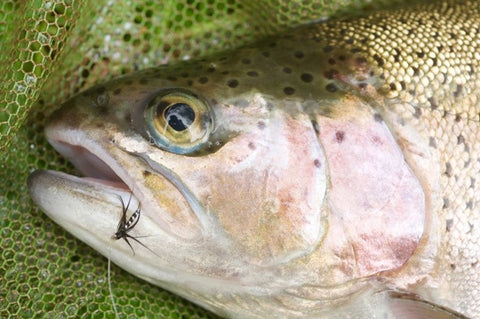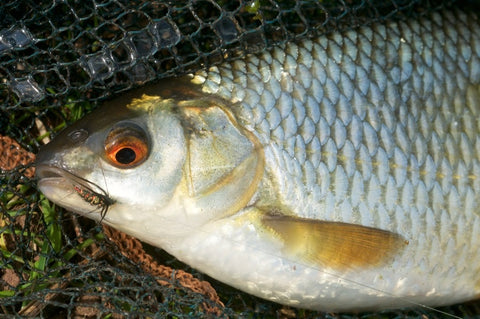9 Deadly Spiders: Top fly patterns and fishing tips
Traditional, understated and so often underused, spider patterns are a must for any fly box. Turrall’s Dom Garnett provides a host of traditional and modern favourites and tips for river and stillwater fly fishing.
There are so many reasons to recommend spider patterns. They are simple to tie, yet so effective for various species. Thanks to their subtlety and excellent movement, they also work in tricky conditions and so even if I don’t start fishing with one, there are always a few ready in my box.

A small water rainbow is hooked on a spider fished just inches deep.
So what exactly is a spider? Traditionally, it is a fly consisting of little more than a thread body and a sparse, mobile hackle. In fact the Americans simply call them “soft hackles”. Flies that date back to the earliest fly fishing.
They are fished wet and tend to work well with very little retrieve. There is such natural movement in the “legs” made of hen, pheasant, starling or any various soft feathers, that they often need little manipulation from the angler. In fact they are a godsend in flat calm conditions, or where there is little movement in the current. I like them for days when the streams are running low and clear, and also for stillwater fishing when there is little wind.
Classic spider patterns

For the ultimate in simplicity and traditional good looks, we should start with some of the basics. The Black and Peacock, Greenwell’s Spider and Black Spider (above) are three to have in any fly box. The Black and Peacock is probably my most used fly of all time, not just for wild trout for me, but large rudd, roach and even carp.

(Above): This rainbow was tempted just beneath the surface with a small spider.
The Black Spider is another classic and about as simple as it gets: A black thread body, a hen hackle and that’s it! It remains an extremely versatile fly though. Fished in the top foot or two of water, it’s a great little fly during a buzzer hatch on lake or river.

Moving on to other spiders, some traditional patterns are more colourful and less realistic, such as the Partridge and Yellow (above L). These flies are useful in stained water or to ring the changes when drab flies won’t work.
Along with the traditional, we also have some newer flies in the mix at Turrall, to target different species. The Moorland Spider (above middle) is ideal for smaller streams, while the Dace Ace is a tiny bead head to try for coarse species.

Spider fishing tips
- You don’t need to impart a lot of action into a spider. The movement is already there, so try fishing these flies with minimal retrieve. Fish at dead drift on the river, or as you’d fish a buzzer on stillwaters.
- Besides being fished wet, small spiders are also excellent fished in the surface film. Try applying some floatant and present a small dark spider on a fine leader; this can be a real frustration saver when fish are rising to tiny insects and bushy dry flies don’t work.
- You can fish them singly, but spiders also work well as part of a team. Try two or even three in different colours to see what the fish want. Because they are so light and sparse, they are not always suitable as a point fly.
- Don’t expect every take to be a line wrencher. Spiders are incredibly easy for fish to inhale and you may get quite subtle bites. Be ready to strike at anything suspicious.
- Spiders are among the best patterns of all to try for different species. I love small dark spiders for roach, rudd and dace. That said, brighter colours are also great fly patterns for bluegills, crappies and other US “panfish”!

Three spiders to tie and try yourself…
Because they are so easy to tie, spiders are also fantastic to make and fill your fly boxes without spending weeks at the vice. That simplicity also makes the style of dressing hugely versatile, whether you tie large or small flies, or want to add your own twist. Here are three I’ve had great success with recently.

(Three spiders to tie yourself. L to R: Spider sedge, JC Midge & Beaded Black and Peacock)
Spider Sedge
This is my ultimate wet fly for chub. Not what was originally intended though, because Spider Sedges are a very old pattern, originally tied in larger sizes and winged to be fished wet or just sub surface.
Hook: Nymph 10-12
Thread: Brown
Rib: Gold wire
Body: Olive Alpaca Dubbing
Thorax: Peacock
Wing: Woodcock slips
Hackle: Grizzle Hen
JC Midge
Adding a sparse hackle to your favourite buzzer patterns is a great trick for stillwater trout and this is a good fly when rainbows are feeding in the upper layers. Be sparing though; you just want a hint of legs so just one turn of hackle is usually more than enough. For coarse species or hatches of tiny midges, you can also try these right down in size 16 or 18.
Hook: Turrall Barbless Grub 12-16
Thread: Black
Rib: UV Multiflash
Body: Partially stripped peacock herl, fine.
Cheeks: Jungle cock
Hackle: Black cock (one turn only)
Beaded UV Black & Peacock
A great fly for coarse fish. Large rudd and roach are usually the target. The usual spiders also work, but for windy days, or when the bigger fish hold a little deeper and you have to get down to them, this is the daddy. It’s also the pattern responsible for my 2lbs 3oz PB rudd, caught this summer.
Hook: Turrall barbless grub
Bead: Metallic Red 2mm
Thread: Black
Tag: UV multiflash (pearl or red)
Body: 2 strands peacock herl
Hackle: Black hen (two turns max).

Spiders are fantastic for rudd; this canal fish took a beaded spider.
Fly tying tips for spider patterns
Less is always more with spiders. This is especially the case with hackles. The old masters of river flies recommended two to two and a half turns of hackle, but modern feathers are so dense, one turn might be enough.
Standard nymph hooks are ideal for spiders, but they also look great on short shank hooks- or even a curved pattern such as grub hook.

A few basic feathers will set you in good stead. Whole capes are brilliant for getting a wide variety of fly sizes, but a few smaller packs of feathers makes a cheaper starting point. Hen is perhaps the easiest to find and use, closely followed by partridge. Traditional materials like woodcock and starling are also excellent and cheap if you can find them.

The same is true with body materials. Keep dubbings sparse, so as not to lose that slim spider profile. That said, you can also add some special effects with just a hint of embellishment. A fine UV rib works well, while it’s no coincidence so many classic spiders have a touch of peacock.
If you like to secure your materials with plenty of turns, a lighter thread is excellent for smaller spider patterns. It’s especially important to avoid bulk and not clog up the hook.
To some extent, proportions are subject to taste. But spiders tend to have slightly short bodies (finish above hook point or barb), but if anything hackles tend to be slightly long.
Try to tie your hackle feather so that the fibres point out at a lively angle, splayed out, like the spokes of an umbrella. Tied like this, they’ll really breathe, so avoid pinning them back or trapping with thread.
Further Reading
For anyone interested in tying the huge range of traditional patterns, or indeed the history of these classic flies, some other books are well worth a read:

A Guide to North Country Flies and How To Tie Them: 140 Flies with Step by Step Photographs (Mike Harding)
–
The North Country Fly: Yorkshire’s Soft Hackle Tradition
(Robert L. Smith)
–
Be sure to keep an eye on the Turrall Flies Facebook page for our latest news, tips and the latest fly patterns.






Leave a comment